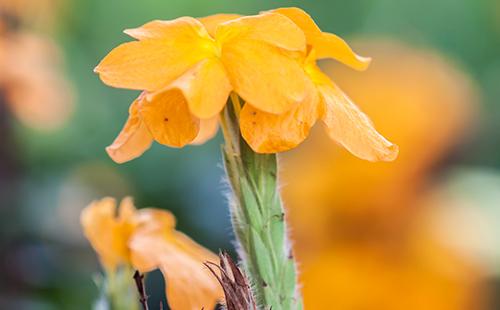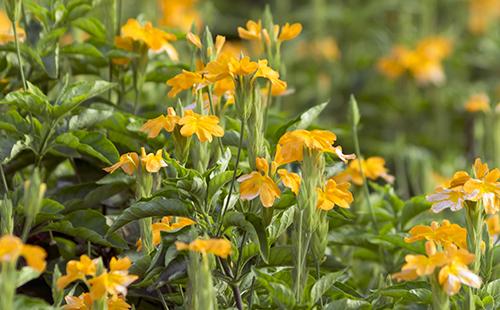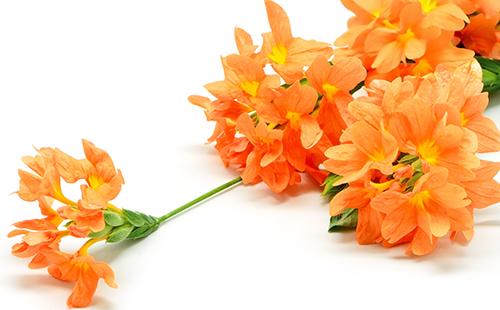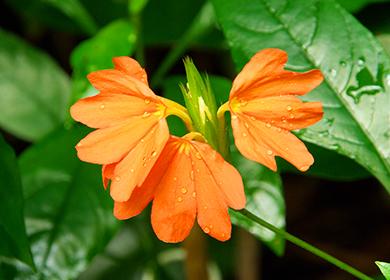The content of the article
In a literal translation from Greek, the name of the plant sounds like "male fringe." Researchers believe that the name of the shrub is a direct indication of its physiological feature. The stamens of the flower have a wavy, fringe-like structure. In the world there are about five dozen varieties of this plant. It can be found in the landscapes of Madagascar, the countries of the African continent and on the Arabian Peninsula. But for our latitudes and our windowsills, only a few varieties of the "eastern star" are suitable.
"Domesticated" varieties
Those cultures that are perennial in the tropical climate are turning into annual garden residents in Europe. And the harsher the climate, the closer the crossander should be to the house. For example, residents of the Black Sea coast can land this beauty in the front garden. And in a temperate climate, you can admire its flowering unless in a pot on the windowsill.
Growing crossander at home is only possible if the variety is selected correctly. Some types of capricious "islanders" are absolutely unsuitable for home floriculture due to the large size. Plant characteristics depending on the variety are shown in the table.
Table - Popular Crossandra Varieties
| Grade name | Height | Features |
|---|---|---|
| Crossandra wavy or funnel-shaped | 60 cm | - Greenhouse shrub; - inflorescences pinkish-orange |
| Mona wellhead | 30-40 cm | - A small dense shrub; - salmon flowers |
| Crossandra Tropic | 25 cm | - Salmon flowers with yellow throat |
| Orange marmalade | Up to 60 cm | - Inflorescences of a bright orange color; - undersized shrub |
| Nile queen | 40-60 cm | - Of all species, this shrub is the most cold-resistant; - inflorescences of salmon color; - durable |
Crossandra care at home: lighting, temperature, watering and top dressing
The answer to the question of how to care for a crossandra consists of three main points:
- provide watering;
- put the pot in a well-lit place;
- feed according to the schedule.
Is there enough light
Our "islet" is a native of the tropics. She is very fond of light, with the exception of direct sunlight. Ideal lighting - diffuse but plentiful. In dark rooms, the flower will develop slowly, and its shoots will be too weak to pamper the gardener with flowering.
How much should be on the thermometer
Extreme cold and unbearable heat are what can kill shrubs. In summer, a tropical resident withstands heat up to 27-28 ° C.In the cold season, its maximum is 16 ° C. Lower temperatures will harm the flower.
How to water
In the summer, watering should be generous and plentiful. The signal that you need to grab onto the watering can is the drying of the top layer of soil. In winter, you should not be so zealous. But it is impossible to completely refuse watering. Ideally, the plant should be moistened once every two weeks. Refusal of watering during this period increases the risk that the "eastern star" will remain without leaves in spring.
How to moisturize
A tropical guest loves moderation in everything, including hydration. Spraying from the spray once a week during the flowering period will be enough for her. The optimum humidity level is from 40% to 60%.

How to fertilize
Fertilizing a flowering "islet" is vital. If the gardener doesn’t feed properly or there is something missing from the bush, this will fully affect the quality and quantity of inflorescences. Reviews of experienced gardeners indicate that every month during the flowering period, crossander needs to be fed twice. For this purpose, conventional mineral fertilizer is suitable.
Care after flowering
How decorative a flower will be depends solely on the talent and skills of the gardener. To do this, you need to know how to care for crossandra after flowering. The algorithm is very simple: to make the bush lush and attractive, you should periodically pinch the tops of the stems. In other words, break off their upper part. This action awakens the buds of the representative of the flora, forcing him to branch more than before.
Breeding
Crossandra propagation occurs in two ways: cuttings and seeds.
Cuttings
Feature. Cuttings are a more popular method of propagation of the “eastern star” because of its simplicity. The best time to root the stalk is the first months of spring.
Action algorithm
- For planting, take a stalk of at least 10 cm.
- We prepare the soil from a mixture of sand, peat, foliage and soddy soil.
- For three weeks we root the cuttings.
- After rooting, we transplant the sprouts, not forgetting the mandatory drainage in the pot.

Seed use
Feature. Seed propagation in the case of the plant under discussion is a rarity. And all because the "eastern star" is stingy with seeds. However, if the flower still deigned to give them, it is worth trying this rare method in practice. Below is a way to grow crossander seeds.
Action algorithm
- We prepare soil from peat and sand.
- Sow the seeds in it.
- We provide a temperature of 23-24 ° C.
- Once a week, spray the "garden".
- After waiting for the sprouts after a couple of weeks, we continue spraying and maintaining the temperature regime.
- We plant seedlings as soon as four or more leaves appear on their shoots.
Reasons for the lack of flowering
Take your time to ask why the crossander is not blooming. Better ask yourself if the beauty of the sun is enough. If in doubt, move the pot closer to the window, or even - if there is such an opportunity - give it a place on the windowsill on the east side. Often, due to a lack of diffused light or artificial lighting, inflorescences fall even in a flowering crossandra.
To stimulate the "eastern star" to the appearance of buds can be not only an abundance of sunlight. Knowing how to pinch a crossander allows you to grow a lushly flowering shrub on a windowsill. Amateur gardeners should also consider that in plants aged three to four years, the flowering intensity is significantly reduced.
Why leaf color changes
Over time and under the influence of external factors, cassandra leaves can change color. Here are some of the most common causes of this phenomenon.
- Leaves blush. If the leaves that are domesticated by your blossoming "islanders" turn red, then the leaf plate is aging. This is a seasonal phenomenon. After reddening, the leaves will fall. And after this, new young leaves will appear on the shoots, which will have a traditional green color. Sometimes the cause of premature reddening of the leaves is direct sunlight on the shoots. To exclude risks, do not expose the plant to direct sunlight.
- Leaves turn yellow. If the leaves of the plant turn yellow, this symptom may indicate a violation of mineral nutrition. Ask yourself how long you have been feeding the plant. If you can’t remember the date of the last feeding, it means it's time to catch up.
- Leaves turn black. If the blossoming beauty has black leaves, then she is too cold. Being a tropical plant, Crossandra always reacts painfully to temperatures below 18 ° C. Another reason for blackening the leaves is stagnation of water in the pot.

About Crossandra's fierce enemies
The first and main pest of the plant is the gardener himself. Improper care provokes diseases of the root system, a change in the color of the foliage, falling color. In order not to become a destroyer of a tropical beauty who has been personally grown, you should competently take care of the crossandra in a pot, observing the basic rules.
Pests
Aphid can attack Crossandra, mealybug and spider mite. The main preventive measure against parasites is persistent periodic spraying of the bush. But one in which moisture does not get on the flowers. How to deal with pests, is shown in the table.
Table - Crossandra pests and methods of dealing with them
| Pest name | Way to fight |
|---|---|
| Aphid | - A small amount of aphids can be washed off by spraying the plants from the spray gun; - with a large number of aphids need to fight insecticides |
| Mealybug | - Using a cotton swab, you need to remove pests and their metabolic products; - three times with an interval of a week, it is necessary to spray the shrub with tincture of calendula |
| Spider mite | - It is possible to neutralize only by spraying the plant with insecticides |
Disease
Among the most common diseases among plants, crossandra is most often affected by cladosporiosis. The popular name for this disease is leaf mold. First, brown spots appear on the leaves of the shrub. And over time, if you do not provide the plant with quick horticultural help, the leaf plate is completely affected. The method of struggle consists of three steps.
- Completely remove the moldy leaves.
- Spray a tropical flower with a fungicide for treatment.
- We provide the plant with the proper moisture level.
The gardener's caring hands are the key to the long flowering of an oriental beauty. Knowing how to care for a crossandra, and putting these rules into practice, you can achieve continuous flowering for three seasons - from mid-spring to late autumn. Growers with experience argue that it is better to transplant the shrub onto the waning moon, and to throw the seeds into the ground - to the growing one.And you will be happy in the form of a magnificent and fragrant color.
Reviews: “The main problem is not to flood”
I bought this winter at the market for a penny a small crossandra jerk, brought it home and carefully transplanted it into a larger pot. During the winter and spring, the flower grew, grew stronger, released several spikelets, and today the first orange flowers have blossomed. The leaves are shiny, dark green, the flower grows in a small bush. The plant feels better in the company of other plants, because likes high humidity. Prefers bright light, but not direct sunlight. In general, the plant is quite unpretentious and very elegant. The main problem is not to flood (the previous one died).
Svetlana Yurievna, http://irecommend.ru/content/moya-krossandra
I have two crosses. Blue and orange. Both behave the same way - the leaves are smaller and ampelous. Pruning does not give anything. Transplanted in the spring in a light substrate of humus, peat, sand and vermiculite. Watering as it dries, southeast window. They have been living for 4 years. Blossom as they want. Healthy as horses, but with small light green leaves and ampel. I would understand if there was little light, but there hibiscus bloom, and this grass receives fertilizing and illumination, and it grows extremely ugly anyway.
E_tutsi, http://www.flowersweb.info/forum/forum1/topic114332/messages/
Krossandra does not like drafts and write that in the summer it is impossible to take out to the street. Mine, too, bloomed all summer, and then I made a haircut and it seems that she was offended by me for this - dried up almost all the branches. There was one small sprout, now I walk around the plant in circles and don’t know how to help, I water often, but the earth dries instantly due to dry air from the batteries.
Nafanya, http://dv-cvet.ru/forum/8-190-1

